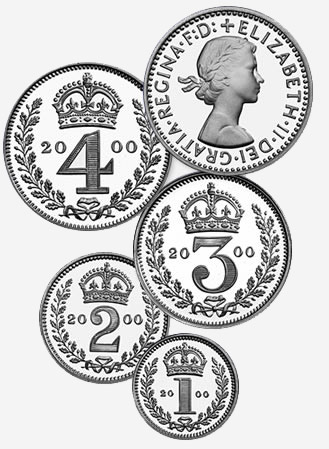Maundy money
By The Royal Mint | Wednesday, 22 February 2012

The Royal Maundy is an ancient ceremony which has its origin in the commandment Christ gave after washing the feet of his disciples on the day before Good Friday. The commandment, or mandatum, that ye love one another (John XIII 34) is still recalled regularly by Christian churches throughout the world and the ceremony of washing the feet of the poor which was accompanied by gifts of food and clothing, can be traced back to the fourth century. It seems to have been the custom as early as the thirteenth century for members of the royal family to take part in Maundy ceremonies, to distribute money and gifts, and to recall Christ's simple act of humility by washing the feet of the poor. Henry IV began the practice of relating the number of recipients of gifts to the sovereign's age, and as it became the custom of the sovereign to perform the ceremony, the event became known as the Royal Maundy.
In the eighteenth century the act of washing the feet of the poor was discontinued and in the nineteenth century money allowances were substituted for the various gifts of food and clothing.
Maundy money as such started in the reign of Charles II with an undated issue of hammered coins in 1662. The coins were a fourpenny, threepenny, twopenny and one penny piece but it was not until 1670 that a dated set of all four coins appeared.
Prior to this, ordinary coinage was used for Maundy gifts, silver pennies alone being used by the Tudors and Stuarts for the ceremony.
Today's recipients of Royal Maundy, as many elderly men and women as there are years in the sovereign's age, are chosen because of the Christian service they have given to the Church and community. At the ceremony which takes place annually on Maundy Thursday, the sovereign hands to each recipient two small leather string purses. One, a red purse, contains – in ordinary coinage – money in lieu of food and clothing; the other, a white purse, contains silver Maundy coins consisting of the same number of pence as the years of the sovereign's age.
Maundy money has remained in much the same form since 1670, and the coins used for the Maundy ceremony have traditionally been struck in sterling silver save for the brief interruptions of Henry Vlll's debasement of the coinage and the general change to 50% silver coins in 1920.
The sterling silver standard (92.5%) was resumed following the Coinage Act of 1946 and in 1971, when decimalisation took place, the face values of the coins were increased from old to new pence.
The effigy of The Queen on ordinary circulating coinage has undergone three changes, but Maundy coins still bear the same portrait of Her Majesty prepared by Mary Gillick for the first coins issued in the year of her coronation in 1953.


